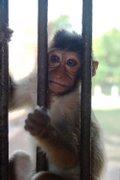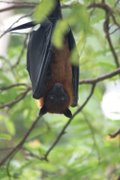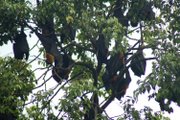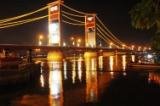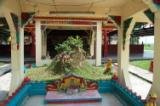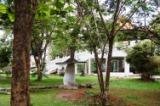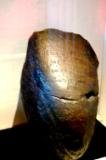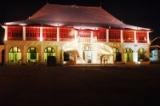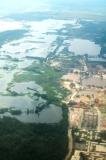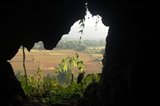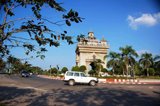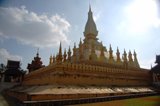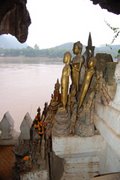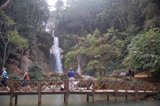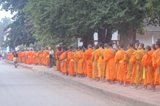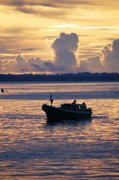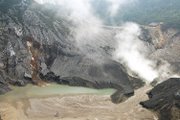The first thing that strikes you when you first enter Laos is that the urinals seemed to be placed rather low, about knee height. A fact which one of my travelling companions rather amusingly observed must be attributed the fact that Laotian men have short legs or they have great aim. Or as he smilingly pointed out they must have assets most South East Asian men would kill for. The Laotians we encountered during our four day visit proved to be of normal South East Asian height, so we are left wondering about the accuracy of their aim and other endowments.
Having sufficiently relieved ourselves for the long journey ahead, we got into our Thai-registered van after having our passports stamped at the Friendship Bridge Immigration checkpoint, one of the main entry points by road into Laos from the Thai town of Nong Khai in north east Thailand. It took a bit of getting used to for as we got out of the immigration complex, the van veered to the right and we made our way to the capital city of Vientiane. Laos, being a former French colony, is right hand drive which did not seem like much of a problem for our Thai driver. Left hand drive, right hand drive, one hand drive with the other on the phone all made no difference to him. He is an expert behind the wheels.
Our first day was to be a very long journey which is going to take up much of the day, about 10 hours. It was to be a journey through rugged country and mountain roads to the old capital of Luang Phabang. We had checked out of our hotel and left the Thai border town of Nong Khai at 7.00am. Our Laotian guide spoke excellent English as opposed to very little French. He explained that knowledge of English now is more of an asset than French, which was once the foreign language of choice in this land-locked nation of 6.3 million people. Those days are long gone. Now it is more fashionable to speak English. The fact that I speak Laotian pretty well even though it was only the second time I set foot in the country did not stop him from conversing in English with me almost the entire time I was there. Of course if you already speak Thai then speaking Laos comes easy enough. About 85 per cent of the words are the same. The divide used to be greater but most Laotians seemed to prefer watching Thai soap operas which are easily received through satellite dish, than their own government controlled development and entertainment programmes. As a result, the Laotians or Lao as they much prefer to be called, and the Thais now speak an almost identical language. The writing, however, differ but comes with similar pronunciations. But if you can figure out the squiggles that make up the Thai alphabet, then reading Lao text comes easy enough.
The journey from Vientiane to Luang Phabang was long and scenic enough with its mountains, valleys and rice fields. And there were just so much Laotian words I was capable of deciphering in a day. If for nothing else it was just to prove to myself that I was still young enough to learn a fourth language. Before long the eyes got weary and it was time for a snooze, but no sooner had all of us got comfortable enough when the van pulled into Vang Vieng, a small town of about 25,000 people. It was lunch time and the restaurant fronted what used to be an airfield for American planes flying sorties into neighbouring Vietnam during the Vietnam War. Now it just looked like a big highway leading to no where.
The town was nothing to shout about but on our return journey from Luang Phabang three days later, we spent the night at a scenic resort called the Elephant Crossing. It is a four-storey resort run by a Laotian man and his Australian wife. We were to find out why this place had grown in popularity especially among Caucasian backpackers. It offers quite a number of water activities like kayaking, rafting and tubing. Costing less than RM15 or so, inclusive of a trip to the launching point 3km away, tubing is actually a favourite pastime of tourists who like to laze around on the slow flowing waters of the Nam Song River on inflated tractor tyres. We were told that in July and August the waters of the Nam Song are actually very swift flowing and tubing can be quite hazardous to health but it was safe enough when we were visiting. Another favourite activity of the tourists is to swing from a platform about five metres high holding on to a piece of elastic rope and trapeze a quarter of the way out to the river. Then at the height of the third swing or so let go of the rope and free fall into the water. Seemed like fun thing to do. Certainly quite fun to watch especially when it was somebody in a skimpy bikini at the end of the rope. Makes for good action photographs too if you can get the speed and aperture right.
The town also consists of many B&B accommodation from below RM40 and a walk in town at night offers a few choices of things to do. This would include shopping for souvenir items, dancing the night away at a disco, having a massage or visit the equivalent of the local mamak restaurant complete with roti canai and teh tarik. You can imagine the happiness on my Malaysian travel companions’ faces when told they would be treated to the Malaysian favourite meal. By some coincidence, enough Malaysians must have visited the restaurant that teh tarik was not an alien name to the proprietor, who hailed from India, but have travelled through Singapore and Malaysia. The restaurant even has a branch in Luang Phabang by the same name. Or was it the head office, we never quite ascertained. American sitcoms are also the in thing, especially with the backpacking community and the folks of Vang Vieng had taken this to new heights. Quite a number of eating places offer the comfort of lying on mattresses with a headrest arranged in a row for you to sit and watch re-runs of Friends. The shops must be sharing the same tapes since several shops would be showing Friends but different episodes at the same time. So you can choose the ones you have not watched and for the price of a coffee or tea sit watching for hours on end.
Another thing not to be missed in Vang Vieng is Tham Chang or Elephant Cave. With an entrance fee of about RM3, you get the privilege of crossing a hanging bridge before climbing a set of steps to a large cavern. From the main cave chamber, you will see one of the most scenic views of the Vang Vieng countryside. Most amazing of all was the fact that there were two rock openings, one shaped like the map of Borneo and the other, a shoe. It was a good thing that we stopped here only on our way back. Otherwise we may have decided to give Luang Phabang, some 300km away, a miss and while away our time in Vang Vieng instead. As it was those were about the only things we got to experience in the town, since we had less than a day there.
Luang Phabang, which used to be the capital of Laos, is now home to only about 25,000. Quite a sizeable number have migrated after the communist takeover in 1975. Now, after being declared a Unesco heritage site, it had turned into a town relying more on tourism than agriculture. Most of the old buildings have remained, some turned into guesthouses either to meet or in expectance of a tourist influx. Those who would not like to endure a van or car ride on Route 13 which connects Vientiane and Luang Phabang can either fly from the Lao capital or from Chiang Mai in north Thailand. But domestic air fares in Laos is quite pricy.
By the time we arrived and checked into our hotel it was way after sundown. A part of the town which had come alive, however, was the night market. A Lao pasar malam selling things from t-shirts and pants to Buddha images and other handicraft items. On both sides of the street are restaurants serving both local and Western food, which seemed to be quite a big thing, whether for dinner, lunch or breakfast. Breakfast at the hotel usually consists of two eggs, coffee and baguette. At least at dinner and lunch we got to sample Lao food, which is not altogether different from Thai food, only with fewer spices and other seasonings.
On our second morning in Laos we visited a village called Ban Lao Lao, just outside of Luang Phabang. The spelling may be the same but the meaning differs. The first Lao means whiskey and the second is of course the country. The village is reputed to produce the best Lao moonshine, containing some 50 per cent alcohol. By some coincidence the village is located on the banks of the Mekong River allowing those who need to cool off after a few shots of the extremely potent stuff to go for a dip. Incidentally the temperature in Luang Phrabang is quite cool in November, so lao Lao was a great way for the people to keep warm.
Here is also located a jetty for you to take a 20-minute boat ride upstream to Wat Tham Xieng Maen, where Buddha images of various types are kept. These images were from temples which have been torched during earlier wars between Laos and its neighbours or from temples which had fallen into disuse. A staircase leads up to another cave where more Buddha images are kept. Here you need a torchlight to find your way around and see the images.
After lunch we headed for Wat Xieng Thong, which is Luang Phabang’s most magnificent temple. Built in 1560, its stupas house Buddha images from some 500 years ago. The walls of the chapel also has beautiful mosaic murals telling stories of the Buddha’s previous life before he attained enlightenment. Then we were off to Kuangsi Waterfall situated in a public park 32km out of town. This several tier waterfall is breathtaking in its beauty and there is even a pool for those who want to go for a swim at the lower level of the falls.
On our final morning in Luang Phabang we were up at 5am in order to go give alms to Buddhist monks. Some 80 over monks from the temples in town walk through the main streets which were lined with tourists and locals alike. Following the communist takeover of Laos in 1975 the practice of giving alms to monks were banned by the government, which felt that monks should go to work like everybody else. But the practice came back a year later after a huge outcry from the public, who felt that a religious practice ingrained in their lives for centuries should not simply be banned at the whims of the government whatever its political beliefs were. Now the practice of alms giving to monks in the early hours of the morning has become both a merit-making exercise and tourist attraction at the same time.
One final place we had to visit before leaving Luang Phabang was the Royal Palace Museum which was built more than 100 years ago. A blend of both Lao and French architecture, the palace was turned into a museum after the last Lao king, Savang Vattana and his family were banished to a remote area in northern Laos near the border with Vietnam in 1977. It was announced by the government that the king and his family were attending a re-education camp. But we were told that they were in fact banished to the cave prisons of Hua Phan close to the border with Vietnam. The king and his family passed away four years later from malnutrition and lack of medical attention.
The Royal Palace Museum is also where the Phabang Buddha image is kept. The Phabang or Phrabang is to the Laotians what the Emerald Buddha is to the Thais in terms of significance. In fact the Phabang image used to be in Thailand after King Rama I carted it back as the spoils of war in the 1700s. But what his great grandfather brought back to Bangkok, King Chulalongkorn or Rama V returned to Laos in the early 1900s. This was about the time when King Rama V also gave up Laos to the French and the northern states of Kelantan, Kedah, Perlis and Terengganu to the British.
Retracing our journey we found ourselves on the final and fourth day in the Lao capital of Vientiene. With a population of over 200,000, it is the exact opposite of Luang Phabang. Here the streets are full of cars and motorcycles as opposed to bicycles. Here is also located the Pathat Luang, the most important national monument of Laos. This symbol of both the Buddhist religion and Lao sovereignty was built in the mid-1500s by King Setthathirat, whose statue sits majestically in front of the magnificent golden structure.
Another attraction not to be missed in town is the Patuxai or Victory Monument. Built in the 1960s, it was patterned after the Arc de Triomphe in Paris, which is exactly what Patuxai means in Laos. It is the most popular park in Vientiene with both the tourists and locals. Standing in front of the Patuxai with wide streets surrounding it, one could not help but whistle a French tune or other. It suddenly felt like a beautiful evening in Paris. Not too far away is the Vientiene Morning Market which contrary to its name stays open well into the late evening. It is a place to catch up on some souvenir buying for the friends back home before we were off to the Friendship Bridge Imigration checkpoint.
While waiting for our passports to be processed, we hopped into the many duty-free shops available. French wine were in abundance. I remembered the first time I was there several years ago. The girl in the duty-free shop had tried to pester me into buying some chocolates. We both had a good laugh when I told her the chocolates were made in Malaysia, where I came from. I just wanted Laotian t-shirts but she had none. She was selling Thai t-shirts instead and I could get a better selection at the Chatuchak Weekend Market in Bangkok.
All the official things over with we hopped into our van which switched back to the left side of the road for the journey into Thailand. One of the most amazing thing was that in the four days we were in Laos, not once did we see a policeman or soldier. But I supposed they must have been lurking inconspicuously somewhere waiting to pounce when you walk out of line. We just could not accept the fact that things can run smoothly even without the people in uniform around to make sure all rules and regulations were followed. After all the people in the Laotian uniforms in the mid-70s did create quite a bit of havoc with their purges and what not. But sure enough as if to make us feel more at home, right after crossing over to Nong Khai we ran smack into a police road block. Civilization at last, you might say.
Friday, May 18, 2007
Subscribe to:
Posts (Atom)

